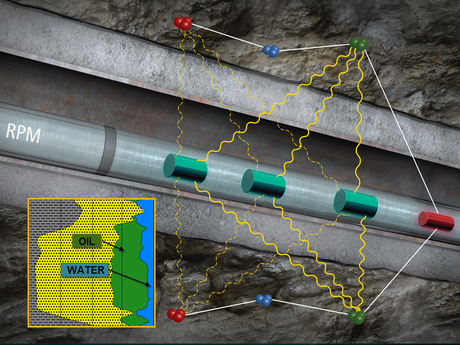Highlights
Highlights
Benefits
- Get fast, accurate quantitative two-phase saturation measurements
- Increase the reliability of processed data with pre-job MCNP modeling
- Choose from several deployment options with memory logging capability
Applications
- Formation fluid saturation monitoring during production in light-oil, mixed-salinity reservoirs
- Identification of bypassed pay zones
- Identification of residual oil saturation and reevaluation of marginal fields
Overview
Gain improved analysis of oil-versus-water saturation in your light-oil reservoirs with the Baker Hughes OilView™ two-phase fluid saturation service. The service provides quantitative, through-casing fluid saturation analysis to resolve the ambiguities in traditional cased-hole formation evaluation techniques.
Rapid logging, reliable analysis
The OilView service processes pulsed-neutron-induced, high-resolution gamma-ray data from the Baker Hughes Reservoir Performance Monitor™ (RPM™) service to increase the speed of carbon/oxygen (C/O) logging. This log provides oil-versus-water saturation in light-oil reservoirs with low or mixed formation water salinity.
The C/O service in most pulsed-neutron measurements is logged at a slower speed than other saturation measurements, which increases the inaccuracy of the results. The OilView service combines inelastic and capture ratios from multiple RPM detectors with a response characterization from a comprehensive, forward-looking Monte Carlo N-Particle (MCNP) modeling database. The result is an oil-versus-water saturation analysis that is obtained 20 times faster than conventional C/O logging, which saves critical rig time.
Unlike traditional Sigma analysis, the OilView service is not as sensitive to formation water salinity changes. This translates to a lower statistical uncertainty of the measurements.
The MCNP modeling generates forward-looking models that predict the response of the curves with varying combinations of mineralogy, formation fluid density, formation gas pressure and density, borehole holdup, and completion configurations. A dynamic curve response envelope algorithm accounts for variations in porosity, mineralogy, and completions, which further increases the reliability of the measured and processed data.
With this accurate quantitative fluid saturation analysis, you can make informed decisions on how, or even if, to extend the productive life of your reservoir.
Contact us to learn how the OilView two-phase fluid saturation service can provide accurate fluid saturation analysis through your casing.


